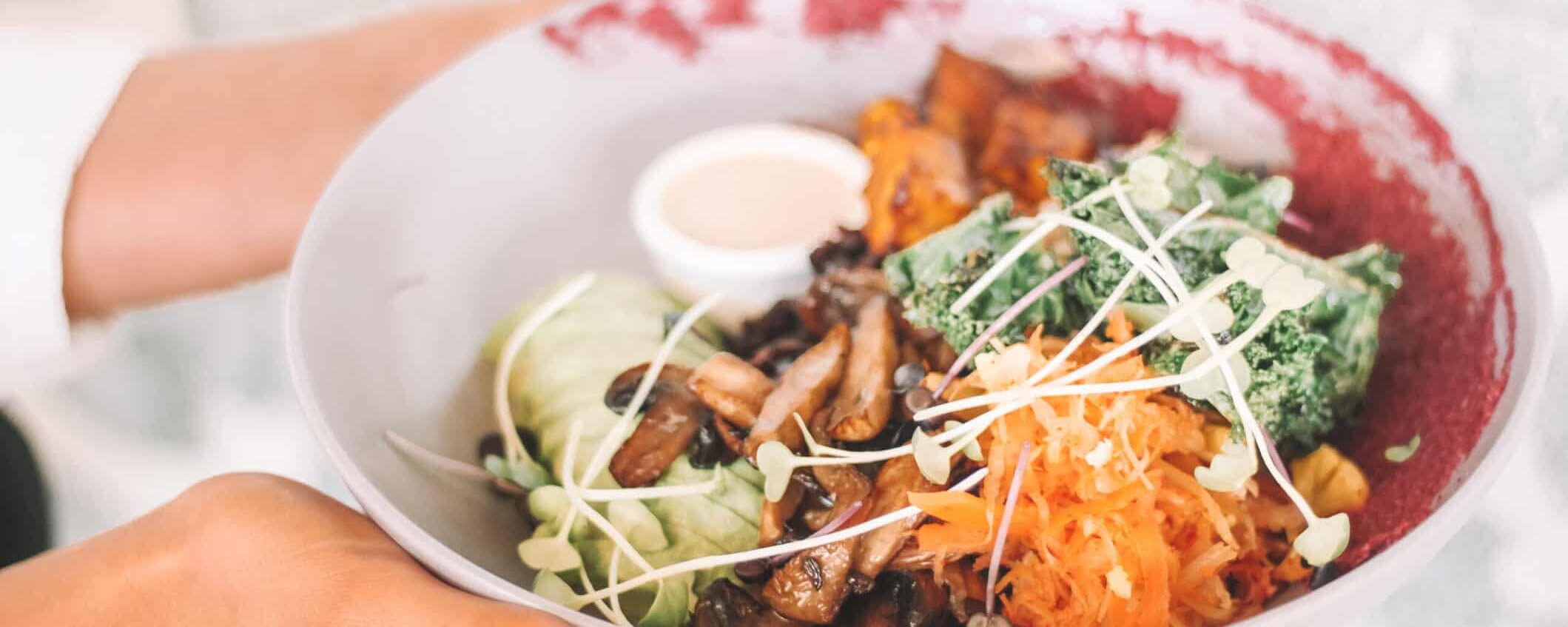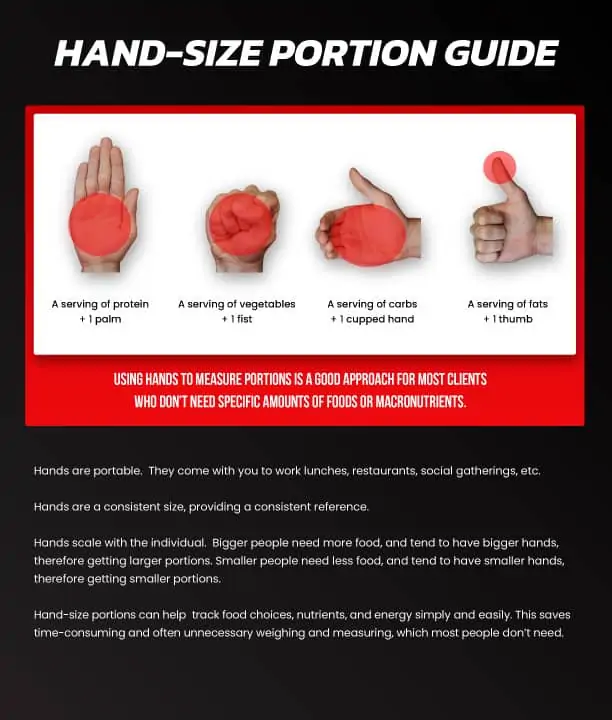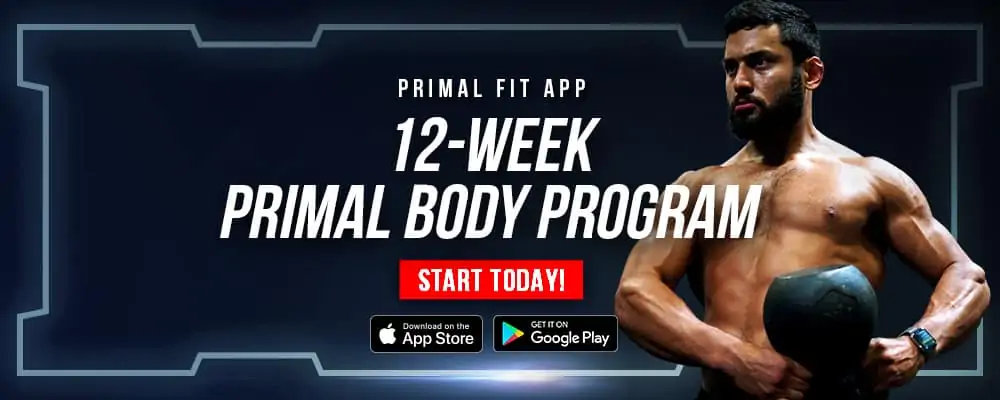
We all know that to start making progress toward our physique, health, and fitness goals … we need to “watch what we eat.”
I know (especially as a beginner) this recommendation can seem vague.
“Watch what I eat? Sure, I’m looking at my food before I eat it! Now how do I watch my consumption properly?”
I have great news: figuring out how to eat is less about pulling out the binoculars on your food, and more about learning easy, adaptable tools that help you quickly measure out portions and calories, minus the anxiety.
Let’s hit our plates with some newfound food strategies.
Where to Start: Portions
Unless you’ve been a serious calorie and macro-tracker for a good length of time, it’s very easy to underestimate the calorie density of certain foods. This is especially true when it comes to size: we tend to equate “bigger” meals with more calories, and small meals or “snacks” as having less calories.
However, this method can fail for one simple reason: a slice of pizza (relatively small in size) can contain significantly more calories than a large bowl of, say, quinoa, chicken, and a ton of veggies with a clean dressing than leaves you feeling stuffed! One is large and will support your dieting, and one is small and can be detrimental to it.
This is why it’s so crucial to start recognizing portion sizes, and to try and eat as many whole-food based meals as possible, because you can roughly estimate your calories and macros much easier.
Portion-tracking can also help you design meals in a way that will keep you feeling fuller for longer, and will make sure you’re getting adequate nutrients with each meal, so nothing is a guessing game.
Measuring Portions 101
When you’re first starting out with measuring portions, it helps to break out the necessary tools: measuring cups, and even a scale if you have one. The reason I recommend this is because most portion sizes on labels display calorie and macro counts based on servings in cups or tablespoons. Getting an eye for what a cup of, say, rice actually looks like can make a huge difference in how many calories you’re actually consuming for the day.
An example of how not gauging correctly when it comes to portion sizes can be trouble is when using oils. A typical oil like olive oil has roughly 120 calories per tablespoon, and a solid amount of fat. Since olive oil is considered “healthy,” we tend to drizzle it on salads and veggies without much thought; however, one large drizzle can easily end up being several tablespoons, adding hundreds of extra calories from fat to a meal.
Once you start measuring out tablespoons, however, you’ll start to get a feel for how much a drizzle actually is. You’ll also be able to estimate portion sizes when you eat out, because your eyes will become accustomed to cup sizes.
Once you are familiar with portions, you’ll also be able to gauge your macros based on cup and ounce size. For example, you’ll be able to notice that a chicken breast serving appears to be 4-5 ounces, which equals 200 – 250 calories, which gives you roughly 30 grams of protein! However, it’s necessary for you to know exactly what 4 ounces of meat looks like, which you can only do by measuring.
Here are some examples of common portion sizes for various foods, which you’ll start to notice once you begin looking at labels:
- Cooked carbs (rice, pasta): 1/2 cup
- Vegetables and salad: 1–2 cups
- Cooked beans: 1/2 cup
- Nut butter: 2 tablespoons
- Cooked meats: 3-4 ounces
Now, of course breaking out the measuring utensils can become tedious after a while – but this doesn’t have to be forever, only until you’ve trained your eye to the correct average portion sizes of foods! Once you’ve done this, you can try out other methods, like the Hand Portion Method we’ll go over in the next section.
If your goal is a serious goal, however (aka; to drop to a very low body fat for a competition or to perform at a high level athletically), you definitely want to stick to using the traditional measuring methods, and begin calculating your macros for your specific goals. Various online calorie and macro calculators can provide specific numbers for your specific goal.
The Hand Portion Method
This is one of my favorite methods of measuring portions, namely due to the convenience and stress-less factor.
The Hand Portion Method is simple: you use your hand as a personalized, portable portion measuring tool! Instead of actually measuring your food, you’re using your hand to gauge portion size.

As you can see, everything you need to measure with relative accuracy your portions is literally in the palm of your hand. This makes this method perfect for most people who live busy lives, but also want to reach a very decent level of fitness.
The only instance hand portions may not be the best route to go is if your goal is very intensive (say, you’re looking to compete in a physique or fitness competition, or achieve a very low body fat percentage), as this requires a very precise measurement of specific macros each day.
Use Your Plate (and Other Tips)
Your plate can actually be a good measurement tool if you need it to be. Check it:
A rough guide for each meal on your plate is:
- Vegetables or salad: Half a plate
- High-quality protein: Quarter of a plate (meat, poultry, fish, eggs, tofu, beans)
- Complex carbs: Quarter of a plate – such as whole grains and starchy vegetables
Other tips for avoiding calorie traps and inaccurate measurements include:
• Don’t eat from the container – it’s unbelievable easy to binge
• Only eat half of your portion when you eat out, as portions tend to be 2-3 times more than a standard meal
• Use smaller dinnerware, as this has proven to help you eat less and give the appearance of eating more
Don’t Forget About Intuitive Eating
Of course, mindfulness when it comes to your diet is just as important as measuring out your calories and macros. Things like paying attention to true hunger cues vs. cravings, noticing sensations before and after eating, and eating slowly until 80% full are all part of “mindfully” eating, and rightfully have a place in all diets.
Sometimes, you just have to listen to your body. Now, this doesn’t mean you listen to your mind telling you that you really need two cheeseburgers. It looks more like realizing you’ve been feeling lethargic for the past couple workout sessions, and you’re really craving carb-like foods all day, so you mindfully indulge in a healthy additional serving of carbs, such as from potatoes or whole grains.
The key here is to distinguish between sabotaging behaviors, such as bingeing on naughty foods every other week, and recognizing cues that your body might need something outside of your prescribed measurements for a particular day.
Where To Start
To begin, you first want to determine your adequate calorie and macros for your goals. Many online calculators will help do this for you.
Once you’ve determined your numbers, then you need to settle on your method. I always recommend getting familiar with measurements using measuring cups and utensils first, then moving on to hand portions once you feel comfortable.
From there, you simply stock up on your clean foods list in accordance with how much you’ll need of each macro, and begin measuring them out with each meal.
Also keep in mind other factors that are going to play a role in reaching your goals, such as adequate sleep, food quality (buy fresh and organic when possible), recovery, small rewards (a square of dark chocolate a day, etc …), and stress management.
If you’re looking for a program that already contains a comprehensive nutrition guide alongside workouts designed to build lean muscle, check out my 12-Week Primal Body Program here >>>
The Bottom Line
• Most people greatly underestimate portions and calorie counts in foods
• Hand Portioning is a convenient, easy method to accurately measure macros and calories
• Calorie Counting and Macro Counting are for precise food measuring for those with strict goals (reaching a very low body fat percentage for competition)
• Intuitive eating can help you adequately fuel your body as it needs
• Start by calculating your calorie and macro needs
